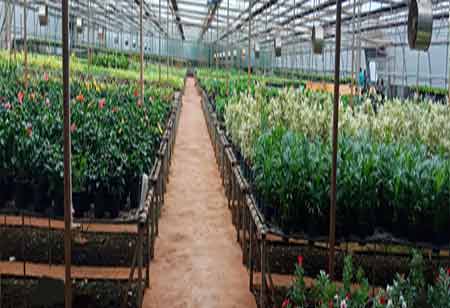Thank you for Subscribing to Agri Business Review Weekly Brief
The Vital Role of Greenhouse Manufacturing in Canadian Agribusiness

By
Agri Business Review | Wednesday, May 21, 2025
Stay ahead of the industry with exclusive feature stories on the top companies, expert insights and the latest news delivered straight to your inbox. Subscribe today.
Canadian greenhouse manufacturers are at the forefront of a transformative era in the nation's agribusiness landscape. Their innovative and evolving sector is not just about constructing shelters but crafting sophisticated, controlled environments that are reshaping how food is grown. This shift enhances food security and significantly contributes to the nation's economic prosperity. The increasing demand for locally grown, fresh, and often organic produce is a key driver for expanding greenhouse agriculture across Canada. This consumer shift has propelled the need for advanced indoor farming solutions, making greenhouse construction a critical component of modern agricultural infrastructure.
Structural Innovations in Canadian Greenhouses
Constructing a modern Canadian greenhouse is complex, involving a blend of traditional engineering principles and cutting-edge agricultural technology. The structural integrity is paramount, and it is built to withstand varied Canadian weather, from heavy snow loads to strong winds. Common structural materials include robust galvanized steel or aluminum, chosen for their strength, durability, and resistance to corrosion in humid environments. These frameworks are then clad with specialized glazing materials. Often tempered and insulated glass offers excellent light transmission and longevity, creating a highly stable internal climate. Polycarbonate panels are also widely used, providing sound insulation, impact resistance, and diffused light, which can benefit certain crops. More economical options like polyethylene films are employed for less permanent or lower-tech structures, offering flexibility and cost-effectiveness. The selection of materials is considered to optimize light penetration, thermal retention, and overall structural resilience.
Advanced Climate and Environmental Control Systems
Beyond the physical structure, Canadian greenhouse manufacturing distinguishes itself by integrating sophisticated environmental control systems. These systems are the brain of the operation, ensuring optimal growing conditions for plants throughout their life cycle. Advanced climate control solutions regulate many factors, including temperature, humidity, and carbon dioxide levels. This is achieved through a combination of automated ventilation systems, often incorporating smart vents and fans, alongside energy-efficient heating and cooling technologies. Heating can be supplied through various means, including natural gas-powered boilers, which are frequently integrated with cogeneration systems that produce electricity and capture CO2 for plant enrichment. Renewable energy solutions like geothermal heat pumps and biomass boilers are also gaining traction, aligning with sustainability goals.
Humidity management is crucial for plant health and disease prevention, with modern greenhouses employing advanced dehumidification systems. Precisely controlling CO2 levels is equally vital, as carbon dioxide is a key component of photosynthesis, and enrichment can significantly boost plant growth and yield. This is often achieved by channeling CO2 from boiler exhaust or dedicated CO2 generators, carefully monitored and controlled by sensors.
Lighting is another critical element, especially during the long Canadian winters. Supplemental lighting systems are a standard feature in high-tech greenhouses. With customizable light spectra, energy-efficient LED lighting allows growers to fine-tune light quality and intensity to optimize plant development and influence flavour profiles. Lighting systems can mimic natural daylight cycles, further enhancing plant productivity.
Water and nutrient management systems represent another area of significant innovation. Canadian greenhouse manufacturers integrate highly efficient irrigation solutions, such as drip irrigation, which delivers water and nutrients directly to the plant root zone, minimizing waste. Recirculating hydroponic systems are widely adopted, where nutrient-rich water is continuously filtered, treated, and reused, dramatically reducing water consumption and nutrient runoff. Technologies like Nutrient Film Technique (NFT) and Deep Water Culture (DWC) are commonplace, enabling soilless cultivation that optimizes nutrient delivery and water usage. Water treatment systems, including ozone treatment, ensure the sterilization and cleanliness of recycled water, enhancing plant health and food safety.
The Role of Automation and Technology in Greenhouse Operations
Automation and robotics increasingly transform greenhouse operations, addressing labor efficiency and precision. Automated seeding and transplanting systems streamline initial planting. At the same time, harvesting robots equipped with computer vision and artificial intelligence can identify ripe produce and gently pick it, reducing manual labor and improving consistency. Autonomous mobile platforms navigate the greenhouse, transporting materials and assisting with various crop maintenance tasks. Data-driven decision-making is a cornerstone of modern greenhouse management, with integrated IoT sensors and predictive analytics platforms collecting real-time data on plant health, environmental conditions, and resource consumption. Machine learning algorithms analyze this data, allowing growers to optimize crop management strategies, predict yields, and proactively address potential issues.
The economic impact of this specialized manufacturing sector on Canadian agribusiness is profound. Greenhouse manufacturing directly supports a significant industry, contributing billions annually to the Canadian economy. The proliferation of high-tech greenhouses has increased domestic production of fruits and vegetables, reducing reliance on imports and enhancing national food security. These facilities create a substantial number of jobs within the greenhouse operations themselves and throughout the supply chain, from construction and technology development to transportation and distribution. The ability to produce fresh produce year-round provides a stable and consistent supply for consumers, fostering a resilient agricultural sector less susceptible to seasonal fluctuations or external supply chain disruptions. Furthermore, Canadian greenhouse manufacturers and the growers they serve actively export high-quality produce, particularly to neighboring markets, further boosting the national economy.
Canadian greenhouse manufacturers are not just building structures but constructing the future of Canadian agriculture. By focusing on robust structural designs, advanced environmental controls, efficient resource management, and embracing automation and data analytics, they drive economic growth and contribute to a more sustainable and food-secure nation.





